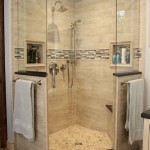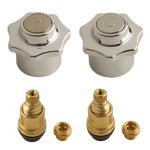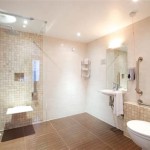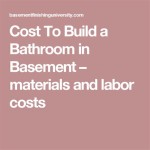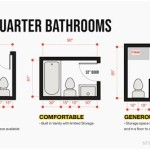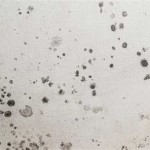Recessed Wall Cabinets for Bathrooms: A Comprehensive Guide
Recessed wall cabinets have emerged as a popular choice for bathroom storage solutions, offering a blend of functionality and aesthetic appeal. Unlike traditional surface-mounted cabinets, recessed models are installed within the wall cavity, creating a streamlined, space-saving design. This article provides a detailed overview of recessed wall cabinets for bathrooms, encompassing their benefits, types, installation considerations, and factors to consider when selecting the ideal cabinet for specific needs.
Space Optimization and Aesthetic Integration
One of the primary advantages of recessed wall cabinets lies in their ability to optimize space, particularly in smaller bathrooms where every square inch counts. By being integrated within the wall, these cabinets minimize protrusion into the room, creating a cleaner, more open feel. This is especially beneficial in powder rooms or bathrooms with limited floor space, as it prevents the feeling of being cramped or restricted. Moreover, recessed cabinets often contribute to a more modern and minimalist aesthetic. The flush-mounted design blends seamlessly with the wall, resulting in a sophisticated and uncluttered look, which contrasts sharply with the visual bulk of surface-mounted alternatives.
The design integration extends to the customization options available. Recessed cabinets can be chosen to complement existing bathroom fixtures and décor, with various door styles, frame finishes, and materials available. From sleek, frameless designs to more traditional, ornate styles, there is a wide range of options to match individual aesthetic preferences. This adaptability allows for a cohesive and harmonious bathroom design where the storage solution becomes an integral part of the overall aesthetic.
Types of Recessed Wall Cabinets
Recessed wall cabinets are available in a diverse range of types, each with its specific features and functionalities. These can be broadly classified based on their door style, material, and internal configuration.
Door Styles: The most common door styles include: * Mirrored Doors: These offer dual functionality, serving as both a storage space and a vanity mirror. They are particularly popular in smaller bathrooms, as they eliminate the need for a separate mirror. * Solid Doors: Constructed from wood, MDF (Medium-Density Fiberboard), or other materials, solid doors provide a more concealed storage solution. They are suitable for storing items that are not intended to be readily visible. * Glass Doors: Glass doors, either clear or frosted, offer a semi-transparent view of the contents inside. They can add a touch of elegance to the bathroom while allowing for easy identification of stored items. * Frameless Doors: These provide a minimalist and contemporary look, with the door extending edge-to-edge without a surrounding frame. * Framed Doors: Featuring a surrounding frame, these doors often lend a more traditional or decorative appeal.
Materials: The materials used in the construction of recessed wall cabinets greatly influence their durability, aesthetics, and moisture resistance. Common materials include: * Wood: Wood cabinets offer a classic and timeless appeal, providing warmth and natural beauty. However, they require proper sealing and maintenance to prevent water damage. * MDF: MDF cabinets are a more affordable alternative to solid wood, offering good stability and resistance to warping. They can be painted or finished to resemble wood. * Stainless Steel: Stainless steel cabinets are highly durable and resistant to corrosion, making them suitable for humid bathroom environments. They often have a modern and industrial aesthetic. * Aluminum: Aluminum cabinets are lightweight and resistant to rust, making them a good choice for damp locations. * Plastic/PVC: Plastic or PVC cabinets are waterproof and easy to clean, making them a practical option for budget-conscious homeowners.
Internal Configuration: The internal configuration of the cabinet determines its storage capacity and organization. Common features include: * Adjustable Shelves: Adjustable shelves allow for customization of the storage space, accommodating items of different heights. * Fixed Shelves: Fixed shelves provide a more stable and permanent storage solution. * Drawers: Drawers offer convenient storage for smaller items, such as makeup, toiletries, and accessories. * Built-in Organizers: Some cabinets include built-in organizers, such as toothbrush holders, razor racks, and makeup trays, to further enhance storage efficiency. * Integrated Lighting: Certain high-end models feature integrated lighting, which provides illumination inside the cabinet for improved visibility.
Installation Considerations and Best Practices
The installation of a recessed wall cabinet involves careful planning and execution to ensure proper fit and stability. Several factors need to be considered before, during, and after the installation process.
Wall Assessment: Before purchasing a recessed cabinet, it is crucial to assess the wall where the cabinet will be installed. This involves identifying the location of studs, electrical wiring, and plumbing pipes. Installing a cabinet over these elements can be problematic and potentially hazardous. A stud finder can be used to locate the studs. If electrical wiring or plumbing is present, it may be necessary to relocate them or choose a different location for the cabinet.
Cabinet Sizing: The size of the cabinet should be carefully considered in relation to the available wall space and the desired storage capacity. Measure the wall cavity accurately to ensure that the cabinet will fit properly. Also, consider the depth of the wall cavity, as some recessed cabinets require a specific depth to be fully recessed.
Cutting the Opening: Once the location and size of the cabinet are determined, the next step is to cut the opening in the wall. This requires precision and care to avoid damaging the surrounding wall. Use a drywall saw or utility knife to carefully cut along the marked lines. It is recommended to cut slightly smaller than the actual cabinet dimensions to allow for adjustments during installation.
Framing the Opening: After cutting the opening, it is necessary to frame the opening with wood supports to provide a secure mounting surface for the cabinet. This usually involves creating a rectangular frame using 2x4 lumber, ensuring that it is level and plumb. The frame should be securely attached to the existing wall studs.
Securing the Cabinet: The cabinet is then inserted into the framed opening and secured to the frame using screws. Ensure that the cabinet is properly aligned and level before tightening the screws. Use shims if necessary to adjust the alignment.
Finishing Touches: Once the cabinet is securely mounted, the final step is to conceal the edges of the cabinet and the surrounding wall. This can be done by applying caulk or paint to the seams, creating a seamless transition between the cabinet and the wall. Trim or molding can also be added to further enhance the aesthetic appeal.
Factors to Consider When Selecting a Recessed Wall Cabinet
Choosing the right recessed wall cabinet involves evaluating several factors to ensure that it meets specific needs and preferences. These factors include size, material, style, budget, and functionality.
Size and Capacity: Assess the storage needs and the available wall space to determine the appropriate size of the cabinet. Consider the depth, width, and height of the cabinet, as well as the number and configuration of shelves and drawers. A larger cabinet will provide more storage space but may require a larger wall opening.
Material and Durability: Choose a material that is durable, moisture-resistant, and aesthetically pleasing. Wood and MDF cabinets offer a classic look, while stainless steel and aluminum cabinets provide modern appeal and enhanced durability. Consider the humidity levels in the bathroom when selecting the material.
Style and Design: Select a cabinet style that complements the existing bathroom décor. Consider the door style, frame finish, and overall design of the cabinet. A minimalist design will blend seamlessly with a modern bathroom, while a more ornate style will suit a traditional bathroom.
Budget: Recessed wall cabinets are available in a wide range of price points. Set a budget before starting the selection process and choose a cabinet that offers the best value for money. Consider the long-term cost of ownership, including maintenance and repair costs.
Functionality: Consider the specific functionalities required of the cabinet. Do you need adjustable shelves, drawers, built-in organizers, or integrated lighting? Choose a cabinet that provides the features that are most important to you.
Ventilation: Consider the ventilation requirements of the cabinet, especially if storing items that are sensitive to moisture. Some cabinets include ventilation openings to prevent the buildup of humidity. If the bathroom is poorly ventilated, consider installing a ventilation fan to reduce moisture levels.
By carefully considering these factors, homeowners can select a recessed wall cabinet that provides optimal storage, enhances the aesthetics of the bathroom, and meets their specific needs and budget. Proper planning and installation are essential to ensure that the cabinet functions correctly and provides years of reliable service.
35 Smart Bathroom Organization Ideas House Recessed Storage Built In Cabinet

Recessed Wall Cabinet For Toilet Paper Storage Sawdust Girl

Coachlight 12 Bathroom Storage Cabinet Combination Unit

Shaker Style Recessed Medicine Cabinets White Black Dark

Built Into Wall Bathroom Cabinets Recessed

Recessed Medicine Cabinet In Stainless Steel 14 X 24 Acu Precision Sheet Metal

Adirhome Bathroom Recessed Wall Cabinet Alpine

Should You Put The Medicine Cabinet On Bathroom Wall Or In It Houzz

Pin On Bathroom Cabinets

Should You Get A Recessed Or Wall Mounted Medicine Cabinet
See Also
